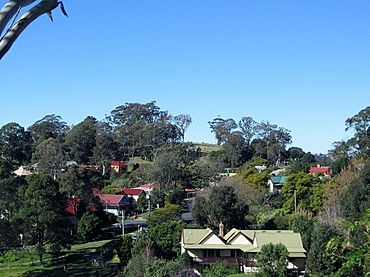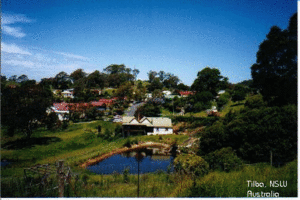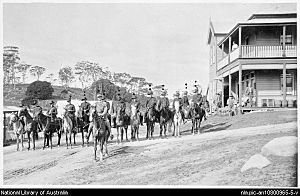Tilba, New South Wales facts for kids
Quick facts for kids Central TilbaNew South Wales |
|
|---|---|

A view of Central Tilba
|
|
| Postcode(s) | 2546 |
| LGA(s) | Eurobodalla Shire |
| State electorate(s) | Bega |
| Federal Division(s) | Eden-Monaro |
Central Tilba and Tilba Tilba are two small villages in New South Wales, Australia. They are located near the Princes Highway. In 2021, about 342 people lived in Central Tilba and its nearby areas. Tilba Tilba had a population of 102 people.
Central Tilba is about 10 kilometers (6 miles) southwest of Narooma. It is also about 60 kilometers (37 miles) north of Bega. The whole village is special. It is protected by the National Trust as the Central Tilba Conservation Area. This means its old buildings and charm are kept safe.
Behind the villages stands Gulaga / Mount Dromedary. This is an extinct volcano. It shaped the land around the area. It also created the nearby Najanuka/Little Dromedary Mountain to the south.
Contents
History of Tilba Villages
The land around Tilba was first home to the Yuin people. They are an Aboriginal nation. The name Tilba Tilba comes from their Thawa language. It means "many waters."
The first European settler, Henry Jefferson Bate, arrived in 1869. He settled near the village of Tilba Tilba. The towns grew during the Australian gold rushes in the 1800s. The Bate family, who were well-known in politics, lived here. Until 1990, the main road, the Princes Highway, went right through Tilba. Then a new bypass road was built.
Gold on Gulaga Mountain
Gold was found on and inside Gulaga Mountain. By 1876, a lot of gold had been found in one creek. It was worth over £10,000. Many miners worked there all the time.
A visitor in 1878 said there was "plenty" of gold. It was easy to get because no blasting was needed. Miners could dig tunnels quickly to find the gold.
In 1896, gold mining mostly involved digging tunnels and using machines to crush the rock. Five tunnels were dug, one below the other. The longest tunnel went over 200 meters (700 feet) into the mountain. About a dozen men worked in the mine. A crushing machine was in a small valley below. The rock was sent down to it using chutes. Some Chinese miners also used water to find gold in the creek bed.
In 1901, the Dromedary mines were still producing gold. Even though the gold veins were small, the gold was very good quality. This meant the miners could still make a profit. In February 1911, the New Mount Dromedary Company mine finally closed.
The Tilba District
In 1876, a visitor described Tilba Tilba as a "beautiful district." They said it had a healthy climate and lovely scenery. The soil was good, and many large dairy farms were starting up. People were quickly buying land. The visitor thought that soon, more butter, cheese, and bacon would be sent out from the area. Bermagui was the port where goods from Tilba were shipped.
In 1891, brothers Sam and Henry Bate had a disagreement. They argued about how to develop the town. Sam disagreed with Henry. So, Sam started Central Tilba about 3 kilometers (1.8 miles) up the mountain.
By 1896, a bridge crossed Wallaga Lake. This connected Tilba to Bermagui. Steamships ran four times a week to Bermagui. At that time, mail came every day except Sunday from Sydney. It traveled by train to Tarago. Then it went by stagecoach through several towns to Moruya, then Tilba, and finally to Bega.
A traveler from that time called Tilba Tilba "a perfect little gem." They said it was in a wild and rugged setting. They thought it was impossible to describe its beauty with words. They strongly suggested that people who found Australian life boring should visit Tilba Tilba.
The ABC Cheese Factory
The ABC Cheese Factory in Central Tilba was the first co-operative cheese factory in New South Wales. A co-operative means farmers worked together to own and run it.
In July 1891, 320 shares were sold. The factory cost £268 to set up. The ABC factory made cheese from September 1891 until 2006. It is still a popular place to visit today.
In 1892, the factory was processing 450 gallons of milk. The Moruya Examiner newspaper reported that the ABC cheese was very popular. They said their Sydney agents could sell "double quantity" of cheese.
In the year ending March 1894, the factory processed 219,000 gallons of milk. This made 228,000 pounds (about 100 tonnes) of cheese. The factory earned £2,994. After paying for costs, the farmers received £2,114.
In 1904, 265,000 gallons of milk were processed. The factory earned £5,841 from cheese. The farmers received £4,618. At this time, there were 15 farms and 800 cows supplying milk. Farmers earned over £300 from the co-op. They also earned about £100 each year from pigs, chickens, and other animals.
In 1905, 313,000 gallons of milk were processed. The factory earned £7,119 from cheese. The farmers received £5,581.
In 1907, 16 dairies within 5 kilometers (3 miles) supplied the factory. One farm with 60 cows on 93 hectares (230 acres) earned £998. About £700 came from milk, and the rest from pigs and other products.
In 1917 and 1918, the factory processed a record 250,000 gallons of milk every six months. Farmers also received record high payments.
In December 1922, the NSW Department of Agriculture said the ABC and Tilba Tilba cheese factories needed to improve. The ABC factory had until May 1924 to build a new, modern building with good water. This news made the people of Tilba very angry. But, people agreed improvements were needed. The factory was still using the same scales even though it was processing much more milk. Wagons with milk cans waited a long time in the hot sun. The milk was getting spoiled because weighing was so slow.
New building plans were started in June 1924. By mid-1925, the new factory was finished. It cost £4,364 to build and £603 for new machines. People said it was one of the best factories in the state. That year, 78 crates of ABC cheese were sold in London for £104. This was the highest price in the market. The company's agents said ABC cheese was "always of excellent quality."
In 1980, a drought greatly reduced milk production. The ABC factory was only handling 2,300 liters of milk a day. This was a quarter of its normal amount.
In 1981, the Bega Dairy Cooperative announced they would close the ABC factory. This was because there wasn't enough milk. Also, the factory was too small. But in December 1981, Geoff and Catherine Bryan bought the factory. They announced it would reopen in February 1982.
In 2012, two local dairy farmers bought the Tilba Factory. They put in new equipment for making cheese and bottling milk. This brought back the tradition of dairy production to Tilba. The milk and cheese made there come from two local dairy farms. One is in Tilba, and the other is in Cobargo. As of 2021, the business is called Tilba Real Dairy. It employs 19 local people. They make award-winning cheese, yogurt, milk, and cream from Jersey milk.
From ABC Coffee Palace to Dromedary Hotel
Today's Dromedary Hotel was built in 1895 for Jim and Emma Livingstone. People say it was built using wood from old ships that docked at Bermagui harbor. The building first opened as the ABC Coffee Palace.
The owner, Mr. Priddle, tried several times to get a license to sell alcohol there. On his third try, on October 3, 1899, he succeeded. Priddle said the Coffee Palace was not making money. He also said the building was on the main south coast road and had been recently fixed up. He reported that the building had 12 rooms, a stable for 8 horses, and two toilets.
After that, the license for the Palace Hotel changed owners many times. In 1924, a newspaper said the hotel had probably changed hands more than any other hotel on the coast.
In 1934, a board decided that the hotel's license would be taken away. The hotel was supposed to close on July 1, 1935.
But then, for "some unknown reason," the hotel was given a new license. Leo Lynch became the new owner. In August 1935, it was announced that the hotel would be renovated. It would get hot and cold water and a septic tank. Its name would also change to "The Dromedary." People thought this was a very fitting name.
In June 1936, the hotel got electricity for its lights.
Images for kids
See also
 In Spanish: Tilba para niños
In Spanish: Tilba para niños







